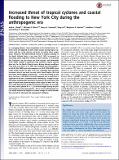| dc.contributor.author | Reed, Andra J. | |
| dc.contributor.author | Mann, Michael E. | |
| dc.contributor.author | Lin, Ning | |
| dc.contributor.author | Horton, Benjamin P. | |
| dc.contributor.author | Kemp, Andrew C. | |
| dc.contributor.author | Donnelly, Jeffrey P. | |
| dc.contributor.author | Emanuel, Kerry Andrew | |
| dc.date.accessioned | 2016-04-19T17:12:58Z | |
| dc.date.available | 2016-04-19T17:12:58Z | |
| dc.date.issued | 2015-10 | |
| dc.date.submitted | 2015-07 | |
| dc.identifier.issn | 0027-8424 | |
| dc.identifier.issn | 1091-6490 | |
| dc.identifier.uri | http://hdl.handle.net/1721.1/102265 | |
| dc.description.abstract | In a changing climate, future inundation of the United States’ Atlantic coast will depend on both storm surges during tropical cyclones and the rising relative sea levels on which those surges occur. However, the observational record of tropical cyclones in the North Atlantic basin is too short (A.D. 1851 to present) to accurately assess long-term trends in storm activity. To overcome this limitation, we use proxy sea level records, and downscale three CMIP5 models to generate large synthetic tropical cyclone data sets for the North Atlantic basin; driving climate conditions span from A.D. 850 to A.D. 2005. We compare pre-anthropogenic era (A.D. 850–1800) and anthropogenic era (A.D.1970–2005) storm surge model results for New York City, exposing links between increased rates of sea level rise and storm flood heights. We find that mean flood heights increased by ∼1.24 m (due mainly to sea level rise) from ∼A.D. 850 to the anthropogenic era, a result that is significant at the 99% confidence level. Additionally, changes in tropical cyclone characteristics have led to increases in the extremes of the types of storms that create the largest storm surges for New York City. As a result, flood risk has greatly increased for the region; for example, the 500-y return period for a ∼2.25-m flood height during the pre-anthropogenic era has decreased to ∼24.4 y in the anthropogenic era. Our results indicate the impacts of climate change on coastal inundation, and call for advanced risk management strategies. | en_US |
| dc.description.sponsorship | National Oceanic and Atmospheric Administration (Grant 424-18 45GZ) | en_US |
| dc.description.sponsorship | National Oceanic and Atmospheric Administration (Grant NA11OAR4310101) | en_US |
| dc.description.sponsorship | National Science Foundation (U.S.) (Award OCE 1458904) | en_US |
| dc.language.iso | en_US | |
| dc.publisher | National Academy of Sciences (U.S.) | en_US |
| dc.relation.isversionof | http://dx.doi.org/10.1073/pnas.1513127112 | en_US |
| dc.rights | Article is made available in accordance with the publisher's policy and may be subject to US copyright law. Please refer to the publisher's site for terms of use. | en_US |
| dc.source | National Academy of Sciences (U.S.) | en_US |
| dc.title | Increased threat of tropical cyclones and coastal flooding to New York City during the anthropogenic era | en_US |
| dc.type | Article | en_US |
| dc.identifier.citation | Reed, Andra J., Michael E. Mann, Kerry A. Emanuel, Ning Lin, Benjamin P. Horton, Andrew C. Kemp, and Jeffrey P. Donnelly. “Increased Threat of Tropical Cyclones and Coastal Flooding to New York City During the Anthropogenic Era.” Proc Natl Acad Sci USA 112, no. 41 (September 28, 2015): 12610–12615. | en_US |
| dc.contributor.department | Massachusetts Institute of Technology. Department of Earth, Atmospheric, and Planetary Sciences | en_US |
| dc.contributor.department | Massachusetts Institute of Technology. Program in Atmospheres, Oceans, and Climate | en_US |
| dc.contributor.mitauthor | Emanuel, Kerry Andrew | en_US |
| dc.relation.journal | Proceedings of the National Academy of Sciences | en_US |
| dc.eprint.version | Final published version | en_US |
| dc.type.uri | http://purl.org/eprint/type/JournalArticle | en_US |
| eprint.status | http://purl.org/eprint/status/PeerReviewed | en_US |
| dspace.orderedauthors | Reed, Andra J.; Mann, Michael E.; Emanuel, Kerry A.; Lin, Ning; Horton, Benjamin P.; Kemp, Andrew C.; Donnelly, Jeffrey P. | en_US |
| dc.identifier.orcid | https://orcid.org/0000-0002-2066-2082 | |
| mit.license | PUBLISHER_POLICY | en_US |
